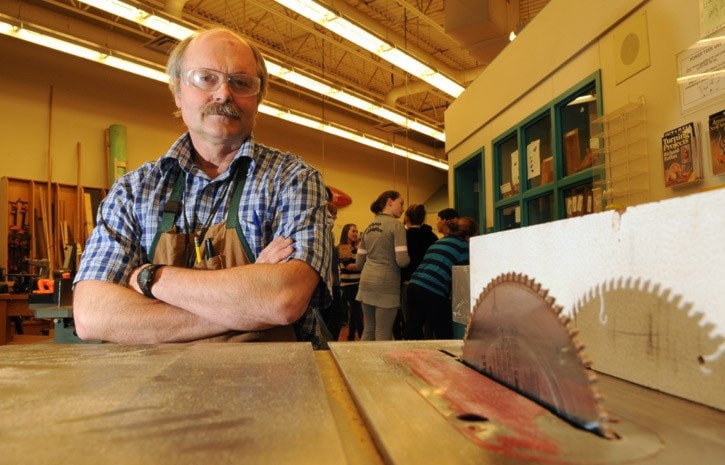Two years ago, Eric Munshaw gave Chilliwack school district an ultimatum: limit shop classes to 24 students or he quits.
After nearly 30 years teaching tech-ed courses, Munshaw felt he could no longer ensure the safety of his students.
His concern was not his abilities; Munshaw is certified in Level 2 first aid, and was trained as a journeyman. It stemmed from administrative and government decision making.
His classes were “over-capacitated.” He had several students with special needs. He had heavy duty power tools in operation.
For Munshaw, a perfect storm was brewing.
Just two months after bringing his concerns about crowded classes to a Chilliwack public board of education meeting in 2009, Munshaw’s worst fears came within a half centimetre of coming true.
One of his students nearly ran his hand through a meat-cutting bandsaw. Had Munshaw not been there to clamp the kid’s hand down on the table, the saw would have cut right through the section between his thumb and forefinger.
“Without me being in the right place at the right time, I wouldn’t have known something was wrong until I had heard the kid screaming,” said Munshaw.
Munshaw later met with the district’s senior executive and told them if numbers were not limited to 24, he would resign.
“I felt I was in an ethical dilemma, that I could not safely supervise these numbers,” he said.
Bob Patterson, then assistant superintendent, convinced Munshaw to rescind his ultimatum and to take the fight provincially.
Two years later, Munshaw is one of six industrial education teachers to collaborate on the BC Technology Education Association’s (BCTEA) Best Practices Guide for Industrial Education.
The guide, which was released in October, is an attempt to put in place official rules and regulations for industrial education classes in B.C..
Safely managing classes has become more difficult in recent years with shops hovering between 25 and 30 students, some as high as 35.
The BCTEA is adamant tech-ed classes have no more than 20 students.
For years shop classes ranged between 20 and 24 students in rooms designed for 24 work stations. Class size regulations, however, were never officially stipulated.
When Bill 33 was passed by the B.C. Education Ministry in 2009, the number of students in a shop class increased across the province. As did the fear of shop teachers.
Bill 33, among other things, enabled class size in grades 4-7 to exceed 30 students with teacher consent, and in grades 8-12 with teacher consultation.
“Teachers are afraid,” said Munshaw. “We’ve been stretched to the point where it’s no longer a manageable situation.
“When you put too many kids in a room like this, it’s a recipe for disaster. The risk of accident is no longer possible, it’s probable.”
Last May, an 18-year-old Ottawa high school student died after a 55-gallon drum containing oil residue exploded in his automotive class.
Since 2007, there have been 705 reported injuries in industrial ed classes in B.C.; 24 from the Chilliwack school district, 17 of which occurred in the last year.
The best practices guide is aimed at preventing injuries.
The guide cites documents from across Canada, the United States, New Zealand and the Workers Compensation Board. It provides guidelines for teacher qualification, training for education assistants, facility design, and class size and composition.
BCTEA expects all school districts to be in alignment with its class size recommendation of no more than 20 students per class by September 2012.
“Having done our due diligence [with this report] the burden is now on the employer,” said Munshaw. “Should an accident occur, we believe all upper management, including administration, school board trustees, Ministry of Education, and government, could be sued if this is ignored.”
Maureen Carradice, secretary treasurer of Chilliwack school district told The Progress it is expected that the recommendations of the best practices guide will be reviewed in the spring, along with the district’s other needs and requirements, when staffing allocations are established for the 2012-13 school year.
That’s not good enough for parent Enid Miller.
Miller’s 16-year-old son, who’s currently enrolled in welding at Sardis secondary, has been taking tech-ed since middle school and has excelled in his courses. But for four years now, Miller, who has been surrounded by mechanics her whole life, has had a pit of fear in her belly.
The classes are too large, she said.
“He’s working with acetylene torches, we’re talking flammable, kaboom equipment,” she said. “I want to know he’s going to be safe in class and trained properly.
“As a parent, it’s hard to stand back and say I don’t want him to take a class because it’s unsafe. I have to have faith in my son, his teachers and the school, but I think it’s unfair that our government and school board is forcing this onto our teachers.
“Believe me, if anything happens to my son, the school board and government will be talking to my lawyer real quick.”
Members of the BC Technology Education Association, including Munshaw, are meeting with B.C. Education Minister George Abbott on Jan. 9 to discuss the best practices guide.
• Related story: Trades training opens window of opportunity for Chilliwack students
